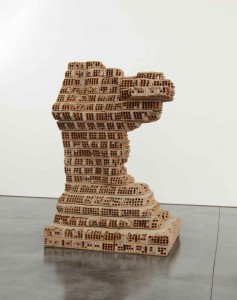« Reviews
Damián Ortega – Capital Less

Damián Ortega, Building #1, 2009, Unique structure, eroded bricks, metallic internal support, 84 11/16 x 63 x 51 3/16 inches, Copyright Damian Ortega, Courtesy Gladstone Gallery, New York
Barbara Gladstone Gallery, New York
September 17 - October 31, 2009
By Jeff Edwards
Long-sighted and quietly but insistently reflective, Damián Ortega sometimes seems like the passionate sage of political artists. Instead of ideological screeds, his best works often read like the musings of a world-weary philosopher compelled to question the value of our endless efforts to secure a future for ourselves. In “CAPITAL Less,” his first exhibition at Barbara Gladstone, several recent creations that initially seem like mere aestheticized reactions to the monstrous potential of urban life quickly reveal deeper, more profound implications.
The core of the show consists of five solid, seven-foot-tall rectangular plinths of red brick and mortar that have been eroded into irregular hulks via pressure sanding. On first glance, they evoke the remnants of a collapsed office block, and it is easy to associate their scarred faces with poverty, urban decay, and the aftermath of disaster and violence. The Mexican artist’s earlier life as a political cartoonist certainly begs such an interpretation, as does his stated concern with using art to reveal the social conflicts inherent in even the most banal of cultural artifacts.
Yet the grittier trappings of sudden catastrophe are noticeably absent. These works contain no allusions to the soot-smeared, slag-littered landscape of a city ground down by war, economic collapse, or natural disaster. Clean as windswept rocks, they instead reflect a slower form of dissolution, hinting at crawling geological decay and the fragile niches that humans have always strived to create in the face of nature’s constant opposition. Walking around the brick mass titled Building #1, one journeys from civilization to the wasteland. One side’s sharp, precise corner gives way to a hole-ridden sloping façade that echoes the stark grandeur of Utah’s Monument Valley, as well as the ancient, long-abandoned Anasazi dwellings found carved into cliffs throughout the Southwest. If eons of time seem to whisper from these artificially eroded monuments, it is only because of their apparent desolation and abandonment.
Two smaller works in the foyer drive home the point that industrial hubris provides no safeguard against the ravages of time. Noodle Soup, a poured concrete sculpture cast from a coiled length of ribbed plastic tubing, transforms human ingenuity into a wormlike fossil. The video Treme-Treme presents a seemingly endless visual ascent up the side of an abandoned urban high-rise. Barring a few shards of broken glass and some barely-legible scrawls, the view looks identical to the desolate, honeycombed brick faces in the main gallery.
As part of Ortega’s larger critique of commodity culture, “CAPITAL Less” has less in common with Karl Marx’s Kapital than with Percy Shelley’s poem Ozymandias and its gentle but sneering mockery of the persistent human belief that monument building is the key to immortality. Ortega opens the window onto a beautiful but harsh world where contemporary civilization and its grand trappings begin to seem like any other frivolous trinket subject to the whims of fashion and the ravages of slow rot.
Jeff Edwards is a freelance writer and a faculty member in the undergraduate Visual and Critical Studies program at the School of Visual Arts (SVA) in New York. A graduate of SVA’s MFA program in Art Criticism and Writing, he also has a Master’s Degree in Public and Private Management from the Yale School of Management.
Filed Under: Reviews


































